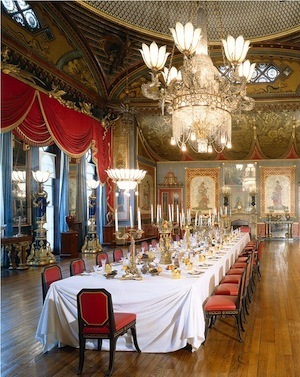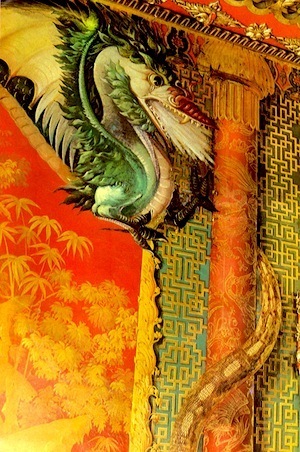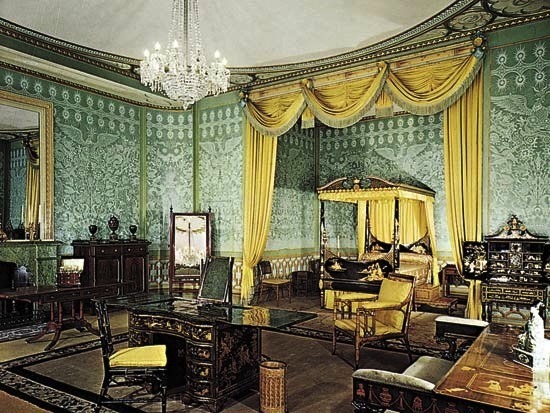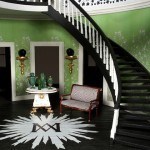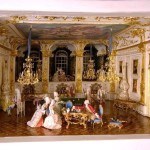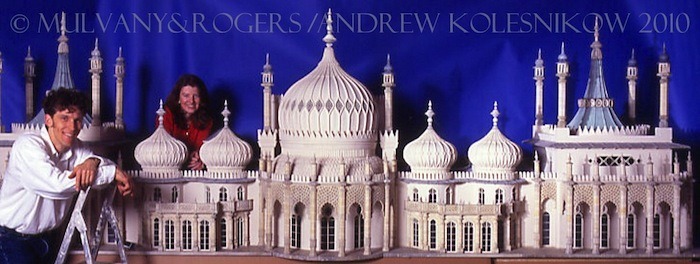
Mulvany & Roger’s Royal Pavilion Dolls House
The Royal Pavilion at Brighton
The Doomsday Book
In the year 1085, William the Conqueror wondered what many rulers through history had pondered. “How much is my realm worth?” The King ordered a survey be taken and whatever numbers were put in the ledger, that was final, just as if it were Judgement Day. Hence the name – Doomsday Book.
I have had a problem finding photographs of the Royal Pavilion dolls house interiors. The photos and drawings in this post are of real rooms. However, with Mulvany and Rogers’ reputation for accuracy, I feel confident these photographs give a good representation of what the dollhouse may look like.
When the survey was completed in 1086, Bristemestune (Brighton) was a sleepy fishing village on the English Channel. Its value was noted at £12 and a tax of 4,000 herring per year was set.

The Banqueting Room of the Royal Pavilion at Brighton, aquatint by John Nash found in the Victoriana Magazine.
Not much changed in the next seven hundred years. In 1750, Brighton’s population was about 1,000, but a change was in the wind. A London specialist in diseases of the glands announced a treatment that required a lengthy stay at the seashore. The cure also required daily doses of a potion made of sea water, woodlice, cuttlefish bones, crabs’ eyes, milk and bicarbonate of soda.
A Boom Town
Brighton became one of London society’s favorite resorts, whether they had a glandular condition or not. The Duke of Cumberland, the future King George IV’s uncle, joined the flow of ex-courtiers who had angered George II in one way or another. The Duke’s transgression was to have suffered a humiliating defeat against Napoleon.
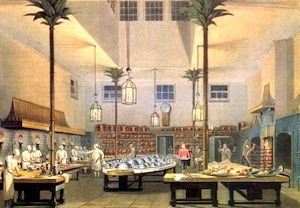
The Great Kitchen from John Nash’s “Views of the Royal Pavilion, 1828”. Found on Victoriana Magazine.
George visited his uncle in 1783 to see if the good doctor could ease the swellings of the glands in his neck. He fell in love with Brighton, but not for the cure. His uncle’s lively circle of friends was the attraction. And the theatre, gambling, horse races, fine dining, music. But most of all — beautiful women.
Three Renovations
While still the Prince of Wales, George rented a “superior farmhouse” in 1787. When his father’s mental health failed and his status changed to Prince Regent, he enlarged the “farmhouse” to the Marine Pavilion in 1811, a small neo-classical structure with a central domed rotunda and glazed exterior. The final renovation, which resulted in the Royal Pavilion we see today, took place when he ascended the throne as George IV. It was completed by architect John Nash in 1823.
The Prince’s extravagant lifestyle angered many of his own ministers and his subjects. Britain was engaged in the Napoleonic Wars, which led to increased taxation, a reduction in exports due to blockades, unemployment, inflation, and extreme poverty for the masses. George IV seemed unfazed. Like his uncle before him, he had found a refuge far from the strictures of London society.
I have had a problem finding photographs of the Royal Pavilion dolls house interiors. The photos and drawings in this post are of real rooms unless otherwise noted. Photos found on Victoriana Magazine have the following notice: Copyright, The Royal Pavilion, Libraries & Museums, Brighton & Hove
Susan Downing, with Patrick Owens
_____________________________________________________________________________________
I invite you to visit my Etsy Shop where I offer many accessories and pieces of furniture in 1:12 scale.


